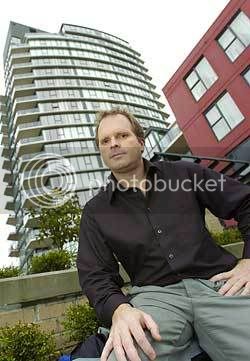Blog Cayo: Don’t Let Density, Taxes Chase Business Out Of Vancouver
 Via the Web site of Vancouver, B.C. Mayor Sam Sullivan comes a full text version of a recent and thoughtful column that’s otherwise now parked behind a subscriber-only firewall. It’s by the Vancouver Sun’s Don Cayo, on the importance of leaving room for business as the city’s residential density continues to intensify. Writes Cayo:
Via the Web site of Vancouver, B.C. Mayor Sam Sullivan comes a full text version of a recent and thoughtful column that’s otherwise now parked behind a subscriber-only firewall. It’s by the Vancouver Sun’s Don Cayo, on the importance of leaving room for business as the city’s residential density continues to intensify. Writes Cayo:
It makes complete sense to develop policies that allow and encourage people to live closer to where they work. The EcoDensity discussion is focused on an important half of the equation — where people will live. But what about the other half? If we succeed in gracefully accommodating a lot more residents within the boundaries of the city, as I think we can, where on earth will they work? I’m not doubting Vancouver’s bright economic prospects with this alarmist question. My worry is space. Is there enough? And will businesses be able to afford to use it?
Cayo cites city documents showing that job growth in the region as a whole between ’96 and ’01 outpaced that in the city eightfold; and that half of the city’s new jobs over the same time were tied to work “with no fixed place,” versus just one-sixth of new jobs in the region. He observes:
In other words, an overwhelming number of the the new jobs located in permanent premises are in the suburbs.
New, ’06 city and regional jobs data which could confirm or mitigate these sharp disparities have been slow in coming, according to Cayo. It will be interesting to see whether the city vs. regional job growth trends he notes from ’96 to ’01 are substantially mitigated when the new figures are released.
With those those differences in mind, Cayo also highlights the sharply higher tax burden on businesses in Vancouver versus nearby suburbs.
…Frank Kelly (is) a Midas dealer who operates auto repair facilities in several Lower Mainland municipalities. He describes two of his locations that are similar in size and configuration. The one in Surrey pays $10,500 in property tax each year, and the one in Vancouver pays $54,800. Such out-of-control costs are creating relentless pressure to convert business property into condos. So it’s not surprising that many business are leaving, and few can afford to come in.
Seattle Post-Intelligencer business columnist Bill Virgin offers his read on Cayo’s column, and opines the same concerns apply in Seattle.
Density advocate Dave Biggs (pictured, above right) of Envision Suntainability Tools, does growth modeling for Vancouver region, B.C. and other clients with his firm’s MetroQuest software. One main aim is to combat sprawl.
Such software is a valuable planning tool. But any attempts to plan regional growth, and design a smart and forward looking urban-suburban transportation system, must factor in that as urban residential density grows, so must opportunities for urban employment. True, some proportion of city-dwellers, having locked onto a good housing deal and enjoying urban amenities, will continue to commute to the suburbs for work. Further, the “knowledge economy” is indisputably here to stay, and suburban job growth is robust.
So in the major cities of Cascadia, special efforts must be made to retain and recruit employers in manufacturing, maritime, import/export and infrastructure service industries; as well as in the white-collar sector. This means the costs of doing business in cities need to be competitively gauged; with tax burden, regulatory structure and the permitting process front and center. And tax burden needs to be understood by all – including density proponents – as a function not only of infrastructure needs, but also of the size and scope of local and regional government.
TECHNORATI TAGS: <a href="http://technorati.com/tag/VANCOUVER, DENSITY, EMPLOYMENT, ECONOMY, TAXES, GROWTH, SEATTLE"rel="tag"VANCOUVER, DENSITY, EMPLOYMENT, ECONOMY, TAXES, GROWTH, SEATTLE
